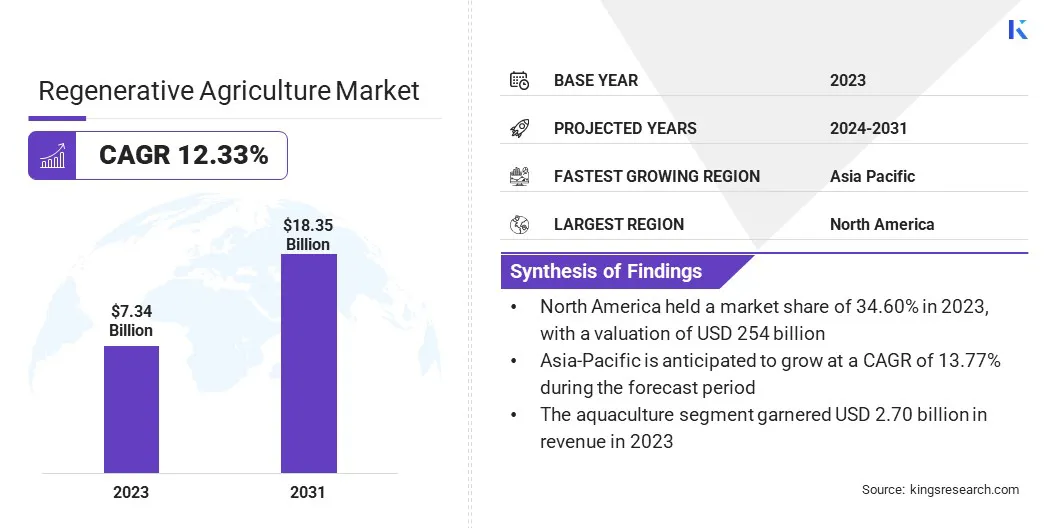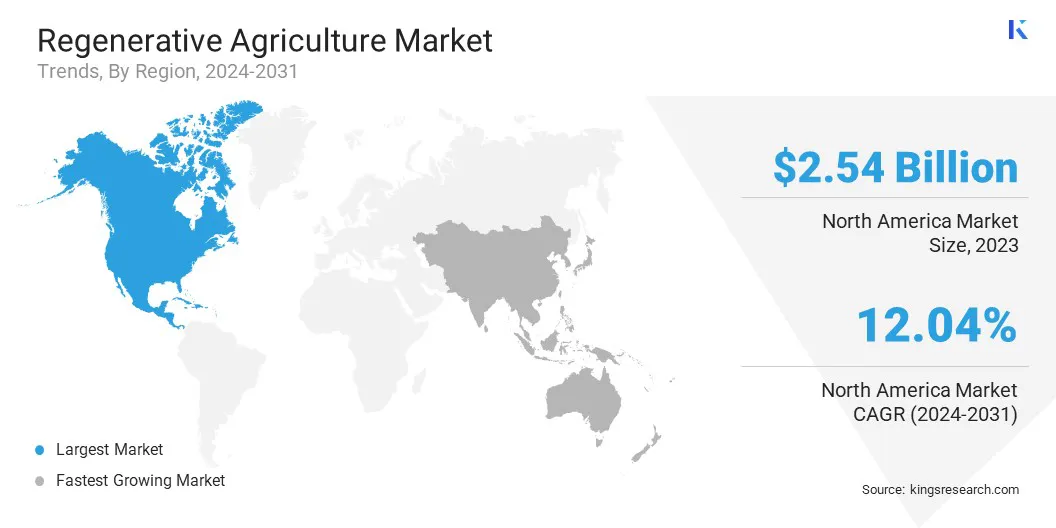Regenerative Agriculture Market Size
Global Regenerative Agriculture Market size was recorded at USD 7.34 billion in 2023, which is estimated to be at USD 8.13 billion in 2024 and projected to reach USD 18.35 billion by 2031, growing at a CAGR of 12.33% from 2024 to 2031. In the scope of work, the report includes solutions offered by companies such as Cargill, Incorporated, Danone SA, General Mills Inc., Grounded, Indigo Ag, Inc., La Delia Verde, Nestlé SA, RegenAG, Soil Capital, Unilever PLC, and others.
The expansion of the regenerative agriculture market is primarily driven by the growing global emphasis on sustainable farming practices. The increase in awareness regarding environmental concerns, particularly regarding soil degradation and ecosystem disruption, is prompting farmers, corporations, and governments to turn toward regenerative techniques to enhance biodiversity, improve water cycles, and boost soil health.
Furthermore, the rising consumer demand for sustainably produced food is prompting more producers to adopt regenerative practices. These factors, coupled with supportive policy frameworks and technological advancements in agricultural methodologies, are significantly supporting the growth of the regenerative agriculture market.
The regenerative agriculture market is experiencing robust expansion as it aligns with global sustainability goals. This market encompasses a variety of practices such as cover cropping, no-till farming, rotational grazing, and compost application, all aimed at restoring soil health and enhancing carbon sequestration. The adoption of these practices has seen considerable uptake across North America, Europe, and parts of Asia-Pacific, fueled by both large-scale commercial farms and smallholder farmers. The increasing involvement of multinational corporations and startups focusing on sustainable agricultural technologies is amplifying the market's growth prospects.
Regenerative agriculture refers to a holistic farming approach that focuses on topsoil regeneration, increasing biodiversity, improving the water cycle, and supporting the biosequestration of carbon. This method strives to restore the natural health and resilience of farm ecosystems, thereby increasing their productivity and sustainability.
Unlike conventional agriculture, which often depletes soil nutrients and causes environmental harm, regenerative agriculture promotes practices that rebuild organic soil matter and reduce pollution through closed-loop, minimal input systems. Integrating principles of permaculture and organic farming enables players involved in the industry to offer a sustainable solution to food security challenges while addressing the pressing issues arising from climate change.

Analyst’s Review
Manufacturers and players in the regenerative agriculture market are developing innovative products and solutions such as Next Generation Agriculture Technology (NEXAT) systems, Radiate Next (plant growth regulators), Dimitra – Blockchain-Based AgTech Solutions, among others. These advancements include precision farming technologies, bio-based fertilizers, and regenerative farming equipment.
Manufacturers are further focusing on sustainable packaging solutions and enhancement in supply chain transparency. These initiatives aim to meet consumer demand for eco-friendly products while promoting regenerative practices throughout the agricultural sector. Major manufacturers in the industry must innovate to comply with sustainable goals and invest in the adoption of regenerative agriculture. Moreover, ensuring traceability in the supply chains is likely to enable manufacturers to ensure the quality of their products.
Regenerative Agriculture Market Growth Factors
The increasing recognition of soil health as a critical component of food security is driving the growth of the regenerative agriculture market. As conventional farming methods, which frequently degrade soil quality over time, undergo reassessed, stakeholders across the food supply chain are adopting regenerative practices. This shift is further supported by the need to enhance soil fertility and structure, thereby facilitating an increase in crop yields sustainably.
Furthermore, stakeholders are investing heavily in education, research, and the implementation of practices that contribute to healthier soils, thereby impacting the expansion of the market. The initial cost and complexity associated with transitioning from conventional to regenerative practices is a significant challenge impeding industry development. Farmers often encounter financial and technical barriers, that deter the widespread adoption of these practices.
To overcome this challenge, governments and private entities are increasingly offering grants, subsidies, and technical assistance to support farmers in this transition. Moreover, the development of a robust carbon credits market is providing financial incentives for farmers to adopt soil-enhancing techniques. These incentives help mitigate the initial hurdles and encourage wider adoption by demonstrating the long-term economic and environmental benefits of regenerative agriculture.
Regenerative Agriculture Market Trends
There is a significant shift toward the integration of digital technologies with regenerative agriculture practices. These integration efforts enhance the precision and efficiency of these sustainable farming methods. Technologies such as remote sensing, soil health monitoring systems, and data analytics are increasingly utilized to track soil carbon levels and biodiversity, enabling informed decision-making. This growing adoption of technology improves the effectiveness of regenerative techniques and appeals to a tech-savvy generation of farmers who are more likely to implement sustainable practices when supported with user-friendly, data-driven tools.
The increasing collaboration between traditional farmers and the scientific community is gaining prevalence in the industry. This partnership is fostering a deeper understanding of ecological and biological processes, which enhances the development and application of regenerative practices. Researchers are continuously discovering new methods aimed at improving soil health and reducing carbon footprints, which leads to practical implementation by farmers. These collaborations are crucial for refining and validating regenerative techniques, thereby increasing their credibility and adoption rate. This underscores the importance of science-based approaches in scaling up regenerative agriculture practices effectively.
Segmentation Analysis
The global regenerative agriculture market is segmented based on type, application, and geography.
By Type
Based on type, the market is segmented into agroforestry, aquaculture, agroecology, holistically managed grazing, and others. The aquaculture segment led the regenerative agriculture market, attaining a valuation of USD 2.70 billion in 2023. This expansion is largely due to the increasing demand for sustainable seafood, coupled with the rising awareness regarding the environmental impact of traditional aquaculture practices.
Regenerative aquaculture practices, such as integrated multi-trophic aquaculture, improve water quality, enhance fish health, and boost the overall productivity of the aquatic ecosystem. Moreover, regulatory support for environmentally friendly farming practices and consumer preference for sustainably sourced seafood is supporting the growth of the segment.
By Application
Based on application, the market is classified into soil and crop management, carbon sequestration, biodiversity, and other applications. The soil and crop management segment secured the largest revenue share of 54.56% in 2023 in the regenerative agriculture market. The expansion of this segment is bolstered by the critical need to restore soil health and enhance crop productivity without relying on chemical inputs.
Regenerative agricultural practices, such as cover cropping, composting, and crop rotation, have experienced growing adoption, with their benefits in enhancing soil organic matter and reducing erosion becoming increasingly evident. Additionally, the increasing global demand for organic food products is prompting farmers to adopt these practices, thereby boosting the growth of the segment by improving yields and soil resilience sustainably.
Regenerative Agriculture Market Regional Analysis
Based on region, the global regenerative agriculture market is classified into North America, Europe, Asia Pacific, MEA, and Latin America.

The North America Regenerative Agriculture Market share stood around 34.60% in 2023 in the global market, with a valuation of USD 2.54 billion. This dominance is primarily due to the region's early adoption of sustainable agricultural practices and significant investment in related technologies. North American farmers and agricultural organizations have been pioneers in implementing practices such as no-till farming, cover cropping, and integrated pest management.
Additionally, strong governmental support and the presence of numerous non-governmental organizations promoting sustainable agriculture have propelled the adoption of regenerative practices, thus solidifying the region’s leading position in the market.
Asia-Pacific is poised to showcase significant growth at a CAGR of 13.77% over the forecast period. This rapid growth is largely attributed to the increasing need to enhance food security and rural livelihoods in the face of rising populations and the challenges posed by climate change. Countries such as China, India, and Australia are actively promoting regenerative practices to combat soil degradation and increase agricultural productivity sustainably.
Moreover, the region is witnessing a notable surge in organic farming and eco-friendly agriculture initiatives, supported by both government policies and private investments. These factors collectively contribute to the development of the Asia-Pacific regenerative agriculture market.
Competitive Landscape
The global regenerative agriculture market study will provide valuable insight with an emphasis on the fragmented nature of the industry. Prominent players are focusing on several key business strategies such as partnerships, mergers and acquisitions, product innovations, and joint ventures to expand their product portfolio and increase their market shares across different regions. Manufacturers are adopting a range of strategic initiatives, including investments in R&D activities, the establishment of new manufacturing facilities, and supply chain optimization, to strengthen their market standing.
List of Key Companies in Regenerative Agriculture Market
- Cargill, Incorporated
- Danone SA
- General Mills Inc.
- Grounded
- Indigo Ag, Inc.
- La Delia Verde
- Nestlé SA
- RegenAG
- Soil Capital
- Unilever PLC
Key Industry Developments
- March 2024 (Partnership): Bayer collaborated with Trinity Agtech, a UK-based company, to advance regenerative agriculture. Trinity Agtech’s Sandy platform aids Bayer’s Carbon Initiative in EMEA by monitoring farm-level carbon. This partnership also tailors Bayer’s solutions for value chain players based on Trinity’s capabilities. Started in 2021, Bayer's European Carbon Initiative is integral to its strategy for sustainable agriculture, aimed at reducing emissions and enhancing soil carbon. By 2025, they plan to expand this initiative significantly.
- October 2023 (Partnership): General Mills, Sam's Club, and Walmart collaborated to promote regenerative agriculture on 600,000 U.S. acres. This initiative, supported by National Fish and Wildlife Foundation grants, aims to improve regenerative outcomes for various crops, including wheat, in the Northern and Southern Great Plains regions. This collaboration enabled both organizations to sustainably pursue their individual sustainability goals.
The Global Regenerative Agriculture Market is Segmented as:
By Type
- Agroforestry
- Aquaculture
- Agroecology
- Holistically Managed Grazing
- Others
By Application
- Soil and Crop Management
- Carbon Sequestration
- Biodiversity
- Other Applications
By Region
- North America
- Europe
- France
- U.K.
- Spain
- Germany
- Italy
- Russia
- Rest of Europe
- Asia-Pacific
- China
- Japan
- India
- South Korea
- Rest of Asia-Pacific
- Middle East & Africa
- GCC
- North Africa
- South Africa
- Rest of Middle East & Africa
- Latin America
- Brazil
- Argentina
- Rest of Latin America


